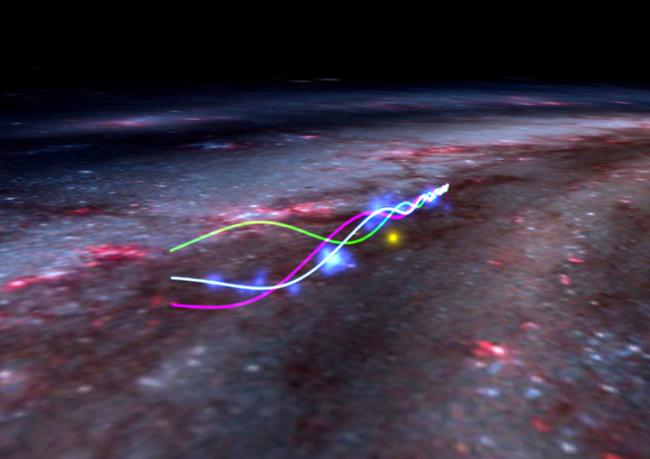- A huge structure of star clouds – containing stellar nurseries – in our sun’s backyard are doin’ the wave! That is, they’re oscillating in such a way as to create a wavelike appearance.
- These star clouds run along the Local Arm of our Milky Way galaxy. Astronomers found them making a wavelike shape in 2020. More recently, they discovered that this string of star clouds is not only shaped like a wave, it’s also doing the wave.
- The structure oscillates due to gravity from the Milky Way. Now astronomers are wondering if this happens all over our galaxy and others.
The Harvard-Smithsonian Center for Astrophysics published this original article on February 20, 2024. Edits by EarthSky.
Star clouds in the Milky Way are doing the wave
A few years ago, astronomers at the Harvard-Smithsonian Center for Astrophysics (CfA) uncovered one of our Milky Way galaxy’s greatest secrets: an enormous, wave-shaped chain of gaseous clouds in our sun’s backyard. The structure is giving birth to clusters of stars along the spiral arm of the galaxy we call home.
Astronomers named this astonishing new structure the Radcliffe Wave, after the Harvard Radcliffe Institute, where they discovered it. On February 20, 2024, researchers said they’ve now discovered the Radcliffe Wave not only looks like a wave, but also moves like one.
In other words, the whole structure oscillating through space, much like “the wave” moving through a stadium full of fans.
The researchers published their discovery in the peer-reviewed journal Nature on February 20, 2024. Lead author Ralf Konietzka of Harvard said:
By using the motion of baby stars born in the gaseous clouds along the Radcliffe Wave. We can trace the motion of their natal gas to show that the Radcliffe Wave is actually waving.
The discovery of the wave structure
In 2018, University of Vienna professor João Alves was a fellow at Harvard Radcliffe Institute and worked with Catherine Zucker and Alyssa Goodman (both currently at CfA). They mapped out the 3D positions of the stellar nurseries in the sun’s galactic neighborhood. They combined brand-new data from the European Space Agency’s Gaia mission with the data-intensive “3D Dust Mapping” technique. And they noticed a pattern emerging, leading to the discovery of the Radcliffe Wave in 2020.
The star clouds are in our backyard
The wave of star clouds is in our own neighborhood. Zucker said:
It’s the largest coherent structure we know of, and it’s really, really close to us. It’s been there the whole time. We just didn’t know about it, because we couldn’t build these high-resolution models of the distribution of gaseous clouds near the sun, in 3D.
The 2020 3D dust map clearly showed the Radcliffe Wave existed, but no measurements available then were good enough to see if the wave was moving. But in 2022, using a newer release of Gaia data, Alves’ group assigned 3D motions to the young star clusters in the Radcliffe Wave. With the clusters’ positions and motions in hand, Konietzka’s team then determined that the entire Radcliffe Wave is indeed waving.
The star clusters along the Radcliffe Wave move up and down, like people in a sports stadium doing “the wave,” creating a pattern that travels through our galactic backyard. Konietzka said:
Similar to how fans in a stadium are being pulled back to their seats by the Earth’s gravity, the Radcliffe Wave oscillates due to the gravity of the Milky Way.
Understanding the behavior of this 9,000-light-year-long, gargantuan structure in our galactic backyard, just 500 light-years away from the sun at its closest point, allows researchers to now turn their attention to even more challenging questions.
Why is the wave happening?
No one yet knows what caused the Radcliffe Wave or why it moves the way it does. Zucker said:
Now we can go and test all these different theories for why the wave formed in the first place.
Konietzka added:
Those theories range from explosions of massive stars, called supernovae, to out-of-galaxy disturbances, like a dwarf satellite galaxy colliding with our Milky Way.

Is dark matter involved?
The Nature article also includes a calculation on how much dark matter might be contributing to the gravity responsible for the Wave’s motion. Konietzka said:
It turns out that no significant dark matter is needed to explain the motion we observe. The gravity of ordinary matter alone is enough to drive the waving of the Wave.
More questions
In addition, the discovery of the oscillation raises new questions about the preponderance of these waves both across the Milky Way and other galaxies. Since the Radcliffe Wave appears to form the backbone of the nearest spiral arm in the Milky Way, the waving of the Wave could imply that spiral arms of galaxies oscillate in general, making galaxies even more dynamic than previously thought. Goodman said:
The question is, what caused the displacement giving rise to the waving we see? And does it happen all over the galaxy? In all galaxies? Does it happen occasionally? Does it happen all the time?
Bottom line: Star clouds peppered with stellar nurseries form a huge, wave-like structure in the Local Arm of our galaxy. Now astronomers have discovered that the structure is in motion, doing the wave.











